初中英语说课稿英文版
初中英语全英说课稿优秀8篇
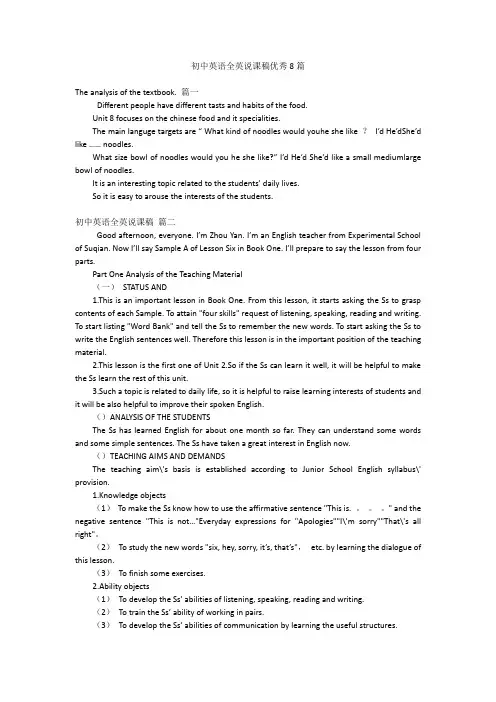
初中英语全英说课稿优秀8篇The analysis of the textbook. 篇一Different people have different tasts and habits of the food.Unit 8 focuses on the chinese food and it specialities.The main languge targets are “ What kind of noodles would youhe she like ?I’d He’dShe’d like …… noodles.What size bowl of noodles would you he she like?” I’d He’d She’d like a small mediumlarge bowl of noodles.It is an interesting topic related to the students’ daily lives.So it is easy to arouse the interests of the students.初中英语全英说课稿篇二Good afternoon, everyone. I’m Zhou Yan. I’m an English teacher from Experimental School of Suqian. Now I’ll say Sample A of Lesson Six in Book One. I’ll prepare to say the lesson from four parts.Part One Analysis of the Teaching Material(一)STATUS AND1.This is an important lesson in Book One. From this lesson, it starts asking the Ss to grasp contents of each Sample. To attain "four skills" request of listening, speaking, reading and writing. To start listing "Word Bank" and tell the Ss to remember the new words. To start asking the Ss to write the English sentences well. Therefore this lesson is in the important position of the teaching material.2.This lesson is the first one of Unit 2.So if the Ss can learn it well, it will be helpful to make the Ss learn the rest of this unit.3.Such a topic is related to daily life, so it is helpful to raise learning interests of students and it will be also helpful to improve their spoken English.()ANALYSIS OF THE STUDENTSThe Ss has learned English for about one month so far. They can understand some words and some simple sentences. The Ss have taken a great interest in English now.()TEACHING AIMS AND DEMANDSThe teaching aim\'s basis is established according to Junior School English syllabus\' provision.1.Knowledge objects(1)To make the Ss know how to use the affirmative sentence "This is. 。
初中英语说课稿范文模板7篇
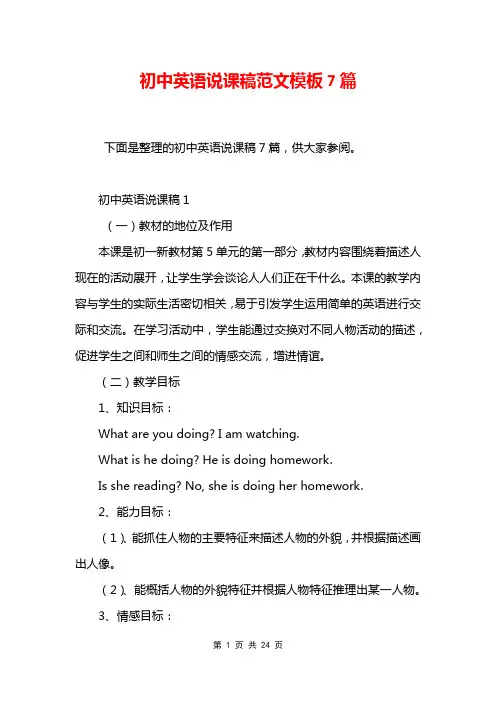
初中英语说课稿范文模板7篇下面是整理的初中英语说课稿7篇,供大家参阅。
初中英语说课稿1(一)教材的地位及作用本课是初一新教材第5单元的第一部分,教材内容围绕着描述人现在的活动展开,让学生学会谈论人人们正在干什么。
本课的教学内容与学生的实际生活密切相关,易于引发学生运用简单的英语进行交际和交流。
在学习活动中,学生能通过交换对不同人物活动的描述,促进学生之间和师生之间的情感交流,增进情谊。
(二)教学目标1、知识目标:What are you doing? I am watching.What is he doing? He is doing homework.Is she reading? No, she is doing her homework.2、能力目标:(1)、能抓住人物的主要特征来描述人物的外貌,并根据描述画出人像。
(2)、能概括人物的外貌特征并根据人物特征推理出某一人物。
3、情感目标:通过描述同学、教师或自己的偶像的外貌,表达自己的看法,使学生在人际交往中学会尊重和理解别人,学会交换不同的看法,了解他人的爱好,增进情谊。
(三)教学重点及难点1、掌握并运用描述人物活动和地点的词汇:watching, doing, eating cleaning, playing, reading, swimming, shopping, pool, school, mall, library2、掌握并运用简单的英语交际句型:What are you doing? I am watching.What is he doing? He is doing homework.Is she reading? No, she is doing her homework.(四)。
教法设计对本课我主要采取了如下几种教法:1.听录音。
听音是英语学习的重要方法,也是课堂教学的重要步骤。
在听中可以感知,可以模仿。
2.重点解释,个别操练。
初中英语全英说课稿优秀9篇
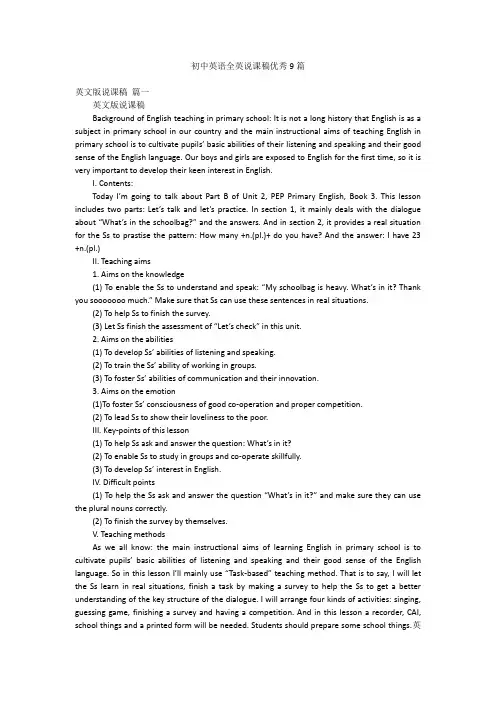
初中英语全英说课稿优秀9篇英文版说课稿篇一英文版说课稿Background of English teaching in primary school: It is not a long history that English is as a subject in primary school in our country and the main instructional aims of teaching English in primary school is to cultivate pupils’ basic abilities of their listening and speaking and their good sense of the English language. Our boys and girls are exposed to English for the first time, so it is very important to develop their keen interest in English.I. Contents:Today I’m going to talk about Part B of Unit 2, PEP Primary English, Book 3. This lesson includes two parts: Let’s talk and let’s practice. In section 1, it mainly deals with the dialogue about “What’s in the schoolbag?” and the answers. And in section 2, it provides a real situation for the Ss to prastise the pattern: How many +n.(pl.)+ do you have? And the answer: I have 23 +n.(pl.)II. Teaching aims1. Aims on the knowledge(1) To enable the Ss to understand and speak: “My schoolbag is heavy. What’s in it? Thank you sooooooo much.” Make sure that Ss can use these sentences in real situations.(2) To help Ss to finish the survey.(3) Let Ss finish the assessment of “Let’s check” in this unit.2. Aims on the abilities(1) To develop Ss’ abilities of listening and speaking.(2) To train the Ss’ ability of working in groups.(3) To foster Ss’ abilities of communication and their innovation.3. Aims on the emotion(1)To foster Ss’ consciousness of good co-operation and proper competition.(2) To lead Ss to show their loveliness to the poor.III. Key-points of this lesson(1) To help Ss ask and answer the question: What’s in it?(2) To enable Ss to study in groups and co-operate skillfully.(3) To develop Ss’ interest in English.IV. Difficult points(1) To help the Ss ask and answer the question “What’s in it?” and make sure they can use the plural nouns correctly.(2) To finish the survey by themselves.V. Teaching methodsAs we all know: the main instructional aims of learning English in primary school is to cultivate pupils’ basic abilities of listening and speaking and their good sense of the English language. So in this lesson I’ll mainly use “Task-based” teaching method. That is to say, I will let the Ss learn in real situations, finish a task by making a survey to help the Ss to get a better understanding of the key structure of the dialogue. I will arrange four kinds of activities: singing, guessing game, finishing a survey and having a competition. And in this lesson a recorder, CAI, school things and a printed form will be needed. Students should prepare some school things.英文版英语说课稿VI. Teaching procedures and purposes of my designing.I’ll finish this lesson in five steps.Step 1. Warm-up and preview1. Free talk between T and Ss about things in the classroom.2. Sing the song together: Books and pencils.3. Do some TPR, for example: Show me your English book. Show me your crayon.4. Review the numbers by asking: “How many crayons do you have?”Purpose: It is important to form a better English learning surrounding for the Ss by singing and doing some total physical response and at the same time it provides situations to review learned knowledge for the next step.Step 2. PresentationNow I’ll mainly talk about this step.1. Present the pattern: “My schoolbag is heavy.” “What’s in it?.”(1) Show a bag and say: “Look! I have a bag.” Carry it and say: “Oh, it is heavy. My schoolbag is heavy.” Help the Ss understand the meaning with the help of my body language. Then lead the Ss to read the sentence. Make sure they can say it correctly.(2) T: My schoolbag is heavy.Open the bag and say: “What’s in it? What’s in my schoolbag?”Take out a Chinese book. Then do the action again. Let the Ss read the sentence.2. Play a guessing game. Divide the whole class into four groups to have a competition.Let them guess: What’s in the bag? How many? Purpose: To present the key structures one by one is much easier for the Ss to learn and grasp the meanings. Proper competition can arouse the Ss’ interest in English learning.3. With the help of the CAI to present the dialogue. Set a situation to help Ss understand: Two Ss are coming. One girl is carrying a heavy bag on her back. They are talking.Girl: My schoolbag is heavy.Boy: What’s in it?Girl: 20 story-books, 32 pencil, 9 rulers, 12 crayons and 30 picture-books. Etc.Boy: What will you do?Girl: They are for the poor.Boy: Great! I’ll bring some school things too.The boy comes back home and puts a lot of things into the bag. Then he goes to school again and gives them to a teacher. While he is taking them out, he is counting the numbers of all things. The teacher says: Thank you soooooooo much.4. Mention that we should take care of the poor.5. Play the cassette. Let the Ss listen and imitate the dialogue.Pay attention to their pronunciation and intonation. Purpose: CAI can provide a real situation for the Ss to understand the dialogue and the relationships between people better. Tell the Ss we should show our loveliness to the Ss.Step 3. PracticeDivide Ss into groups of six children. Each one would finish the printed form by asking and answering: How many storybooks do you have? Find out which group finishes faster. Story books picture-books sharpeners crayons pencils erasers pencil-cases rulers Chen Jie 8 24 3 32 26 4 1 3Purpose: Task-based teaching method is used here to develop Ss’ ability of communication and also their ability of co-operation will be well trained.Step 4. AssessmentHelp Ss finish “Let’s check” of this unit and workbook.Purpose: To check the knowledge Ss have learned in this period.Step 5. Add-activity1. Let Ss tell each other how many school things they have after class. Tell their parents how many school things they have at home.2. Take care of everything they have.Purpose: Revision is so important that Ss should speak English as much as they as in class or after class. It is necessary for the Ss to do some extensive exercises after class to consolidate the knowledge they learned.英文版英语说课稿初中英语说课稿篇二今天我的说课内容是新目标英语八年级上册第四单元第一课时。
初中英语全英说课稿(优秀5篇)
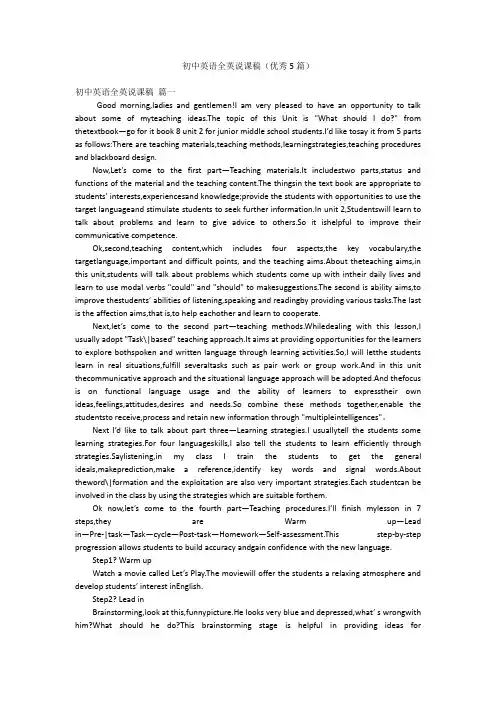
初中英语全英说课稿(优秀5篇)初中英语全英说课稿篇一Good morning,ladies and gentlemen!I am very pleased to have an opportunity to talk about some of myteaching ideas.The topic of this Unit is "What should I do?" from thetextbook—go for it book 8 unit 2 for junior middle school students.I’d like tosay it from 5 parts as follows:There are teaching materials,teaching methods,learningstrategies,teaching procedures and blackboard design.Now,Let’s come to the first part—Teaching materials.It includestwo parts,status and functions of the material and the teaching content.The thingsin the text book are appropriate to students’ interests,experiencesand knowledge;provide the students with opportunities to use the target languageand stimulate students to seek further information.In unit 2,Studentswill learn to talk about problems and learn to give advice to others.So it ishelpful to improve their communicative competence.Ok,second,teaching content,which includes four aspects,the key vocabulary,the targetlanguage,important and difficult points, and the teaching aims.About theteaching aims,in this unit,students will talk about problems which students come up with intheir daily lives and learn to use modal verbs "could" and "should" to makesuggestions.The second is ability aims,to improve thestudents’ abilities of listening,speaking and readingby providing various tasks.The last is the affection aims,that is,to help eachother and learn to cooperate.Next,let’s come to the second part—teaching methods.Whiledealing with this lesson,I usually adopt "Task\|based" teaching approach.It aims at providing opportunities for the learners to explore bothspoken and written language through learning activities.So,I will letthe students learn in real situations,fulfill severaltasks such as pair work or group work.And in this unit thecommunicative approach and the situational language approach will be adopted.And thefocus is on functional language usage and the ability of learners to expresstheir own ideas,feelings,attitudes,desires and needs.So combine these methods together,enable the studentsto receive,process and retain new information through "multipleintelligences"。
初中英语说课稿英文版
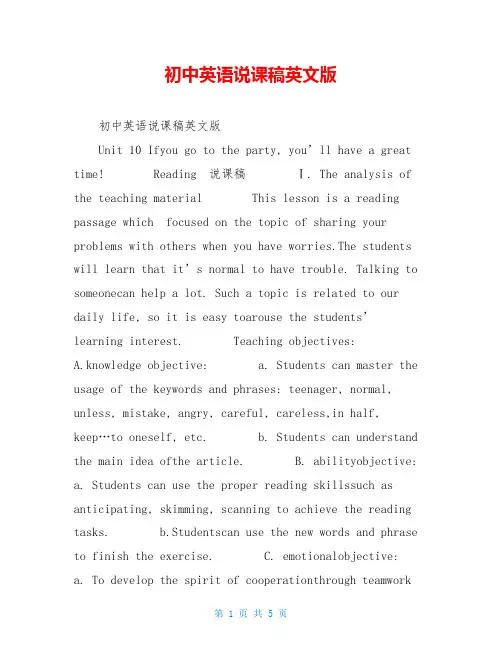
初中英语说课稿英文版初中英语说课稿英文版Unit 10 Ifyou go to the party, you’ll have a great time! Reading 说课稿Ⅰ. The analysis of the teaching material This lesson is a reading passage which focused on the topic of sharing your problems with others when you have worries.The students will learn that it’s normal to have trouble. Talking to someonecan help a lot. Such a topic is related to our daily life, so it is easy toarouse the students’ learning interest. Teaching objectives:A.knowledge objective: a. Students can master the usage of the keywords and phrases: teenager, normal, unless, mistake, angry, careful, careless,in half, keep…to oneself, etc. b. Students can understand the main idea ofthe article.B. abilityobjective: a. Students can use the proper reading skillssuch as anticipating, skimming, scanning to achieve the reading tasks. b.Studentscan use the new words and phrase to finish the exercise.C. emotionalobjective: a. To develop the spirit of cooperationthrough teamworkand pair-discussion. b. To arouse students’interest in Englishlearning. c. To help studentsget the proper ways tosolve problems. Key and difficult points: A. keypoints: a. Tomaster the usageof the key words and phrases. b.To use the properreading skills to achieve the reading tasks. B. difficultpoint: Enable studentsto use the new words andphrases to express their ideas in daily life. Ⅱ. Theanalysis of students The Students have been learning English forsome years. They understand some words and simple sentences. They are curiousand active. They enjoy learning throughcooperation in a relaxing atmosphere. However,theirEnglish learning levels are different from each other. Most of them don’thave enough English to express what to do when they have problems. They need theteacher’s help and encouragement in their further study. Ⅲ. Teaching methods In this lesson, I will use audio-visualteaching method, municative teaching method andtask-based teaching method.Besides, (.fwsir.)multimedia, blackboard, tape recorder are needed as the teaching aids. Ⅳ. Teaching procedures Step 1 Warming-up (5minutes)Play a video. Students watch it and talk about thefollowing questions: What kind of things do they worry about? What will you do if you have the same problem? Step 2 Pre-reading (8 minutes)1. Show some funny pictures and sentences onPPT. Lead students to guess the meaning of the new words. Learn the new wordsand phrases. 2. According to the picture on the textbook,ask students to predict the main idea of the passage. Step 3 While-reading (18 minutes)1. Skim the passage quickly and choose the main idea(a,b or c)。
初中英语说课稿(优秀6篇)
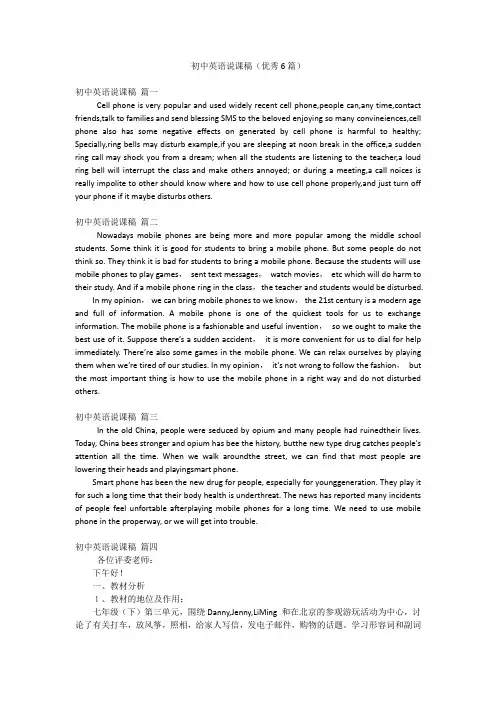
初中英语说课稿(优秀6篇)初中英语说课稿篇一Cell phone is very popular and used widely recent cell phone,people can,any time,contact friends,talk to families and send blessing SMS to the beloved enjoying so many convineiences,cell phone also has some negative effects on generated by cell phone is harmful to healthy; Specially,ring bells may disturb example,if you are sleeping at noon break in the office,a sudden ring call may shock you from a dream; when all the students are listening to the teacher,a loud ring bell will interrupt the class and make others annoyed; or during a meeting,a call noices is really impolite to other should know where and how to use cell phone properly,and just turn off your phone if it maybe disturbs others.初中英语说课稿篇二Nowadays mobile phones are being more and more popular among the middle school students. Some think it is good for students to bring a mobile phone. But some people do not think so. They think it is bad for students to bring a mobile phone. Because the students will use mobile phones to play games,sent text messages,watch movies,etc which will do harm to their study. And if a mobile phone ring in the class,the teacher and students would be disturbed.In my opinion,we can bring mobile phones to we know,the 21st century is a modern age and full of information. A mobile phone is one of the quickest tools for us to exchange information. The mobile phone is a fashionable and useful invention,so we ought to make the best use of it. Suppose there’s a sudden accident,it is more convenient for us to dial for help immediately. There’re also some games in the mobile phone. We can relax ourselves by playing them when we’re tired of our studies. In my opinion,it’s not wrong to follow the fashion,but the most important thing is how to use the mobile phone in a right way and do not disturbed others.初中英语说课稿篇三In the old China, people were seduced by opium and many people had ruinedtheir lives. Today, China bees stronger and opium has bee the history, butthe new type drug catches people's attention all the time. When we walk aroundthe street, we can find that most people are lowering their heads and playingsmart phone.Smart phone has been the new drug for people, especially for younggeneration. They play it for such a long time that their body health is underthreat. The news has reported many incidents of people feel unfortable afterplaying mobile phones for a long time. We need to use mobile phone in the properway, or we will get into trouble.初中英语说课稿篇四各位评委老师:下午好!一、教材分析1、教材的地位及作用:七年级(下)第三单元,围绕Danny,Jenny,LiMing 和在北京的参观游玩活动为中心,讨论了有关打车,放风筝,照相,给家人写信,发电子邮件,购物的话题。
(完整版)初中英语说课稿(英文版).doc
初中英语说课稿肇州县兴城中学孙立敏一、教材(教材分析)Analyzing teaching material1. 型 lesson type (Dialogue/ reading/ listening/ revision)2. 本在教材中的地位status and functionLesson 33 Saving the Earth is a dialogue. The lesson is focused on the topic of the problems of the earth and the functional items of Supposition/ Intentions/ conjecture/ Prohibition. Since it is a dialogue / reading. Itimprove the Ss communicative/ reading ability.3. 教学指思想teaching guideline(Teaching syllabus: Language is for communication, develop their four skills, lay special emphasis on reading; Grellet put it well in his book developing reading skills: develop reading skill/ discourse analysis; get them to understand the western culture better; improve the ability to discover, analyze & solve the problems; Reading is for information, for fun; Use Top- down model or Bottom- up model to activate Ss schemata; Interactive model) 4. 教学目和要求 Teaching aims and demands (⋯ be intended for Ss in key schools)1)知目knowledge objectsa. Enable the Ss to remember the following new words & phrases:Damage, lecture, pollute, pollution, room, standing room, be fit for, hear about, turn intob. Get the Ss to be familiar with this sentence pattern:If the population keeps growing so quickly, there will only be standing room left ⋯Give the Ss a reinforced practice on the functional item Supposition.c. Activate Ss schemata regarding the topic of pollution and help Ss to know more about the problem of pollution.2)智能目ability objectsa. Ask the Ss to make up a similar dialogue.b. Help them to understand the dialogue better and improve the four skills.c. Develop their ability of thinking independently.d. Cultivate their ability to discover, analyze and solve problems.e. Train them to collect information from the Internet.f. Train them with some effective learning methods to optimize Ss ’ learning results. 3)德育目moral objectsa. Arouse their interest in learning English;b. Help them to understand the background of pollution.c. Enable the students to love our earth and the nature.d. Be aware of the importance of stopping pollution & protecting out environment.e. Encourage the Ss to do something to save the earth.5. 教学重点teaching important points ( 生、句型;培养技能 )a. New words and phrasesb. Sentence pattern: If- clausec. improve their reading skills.d. Talking about problems of the Earth.6. 教学点teaching difficult points ( 法;展交能力 )a. functional item: Supposition.b. Develop their communicative ability. Act out their own dialogue.7. 说教具teaching aids (multi-media computer, software, OHP)The teaching syllabus says that it ’ s necessary for teachers to use modern teaching facilities. It increase the class density and improve our teaching result. It can also make the Ss reach a better understanding of the text by making the classes lively and interesting. At the same time, it arouses the Ss’interest in learning English.二、说教法Teaching methodsFive step method; audio-video; communicative approach;Task-based learning: New Syllabus Design encourages teachers to use this teaching method. TBLT can stimulate Ss’ initiative in learning and develop their ability in language application. Make the Ss the real masters in class while the teacher himself acts as the director and bring their ability into full play.三、说学法Study methods1.Teach Ss how to be successful language learners.2.Teach Ss how to develop the reading skill — skim & scan; how to communicate with others; how to learn new words; how to learn independently;3.Get the Ss to form good learning habits.四、说教学过程Teaching proceduresI.复习 (Revision) 5min (Daily report; 词汇 diagram; brainstorming; activate schemata)Activity 1: Imagination1). Suppose a bottle of ink is turned over and dirties your white shirt, what is to be done? (Wash it? Or throwit away?)2). Suppose you catch a bad cold, what’ s to be done?3). Suppose your bike is broken, what’ s to be done?4). And suppose the earth, on which we all live, is damaged, what’ s to be done?*What can you think of when you see “ pollution this”word?(waste, environment, air, water, factory, desert, climate... Try to activate the Ss schemata regarding the topic of pollution.)II.呈现 (Presentation) 5minActivity 2: PresentationPlay the song“ Earth Song” sung by Michael Jackson. (Create an atmosphere)A lot of pictures and video clips about the causes and results of the three problems mentioned in this lesson will be shown on the screen with the help of the computer.Ss’presentation on pollution. Attract their attention, arouse their interest, and create a good atmosphere for communication.*Activate their schemata and cultivate their ability in collecting information from the Internet and developtheir ability in thinking independently.1.Pre- readingActivity 3: Prediction1st listening/ fast reading, one guided Q to help Ss to get the main idea:What do you think is discussed at the conference?2.While- readingActivity 4: Read and answer2nd listening/ careful reading, more Qs to get the detailed information. Develop their reading skills: skim & scan. Pay attention to the pronunciation, stress & intonation.* 阅读 : Pre-reading; while-reading; post-reading (fast reading/ careful reading; skim/ scan; 识别关键词 key words;确定主题句;创设信息差 information gap ;T or F; 填表格 chart/diagram; Predicting; Make a timeline; Make a story map 。
初中英语说课稿优秀8篇
初中英语说课稿优秀8篇初中英语说课稿篇一一、教材分析:教材概述:《新目标英语》Go for it !每个单元包括section A , section B,跟self check三个,部分其中A 部分是基本的语言内容,B部分是知识的扩展跟综合的语言运用。
Self check 部分是让学生用来自我检测本单元所学的语言知识。
教材突出语言使用能力的培养,它采用任务型语言教学模式,每个单元都设计成一个或几个与该单元话题有关的任务,让学生在完成任务的过程中,使用英语获取信息,进行交流,真正体现了在“在做中学”“在学中用”的教学理念。
单元内容分析:本单元的标题为This is my sister ,教材以family members 为中心话题,围绕着“介绍家人跟朋友”展开,学习跟运用目标语言“介绍人物跟识别人物”本单元的教学内容:1.掌握词汇father ,mother ,grandfather, grandmother , brother ,sister , cousin ,daughter ,son ,uncle ,aunt ,parent(s),grandparent(S)friend. 等2.补充词汇husband wife son-in-law daughter-in-law mother-in -law father-in -law, nephew , niece等3.介绍他人的句型This/That is… , These/Those are…4.询问,辨认人物的疑问句形式Is this/that…?二、教学设计思路《新目标英语》中的具体语言目标是通过各种各样的tasks来实现的,学生需要运用具体而特定的行动来完成一定的交际任务,整个教学过程中就是各种语言结构与语言功能与不同的学习任务有机的结合,因此,本单元我将始终引导学生通过完成具体的任务活动来学习语言,让学生为了特定的学习目的去实施特定的语言行动,通过完成特定的交际任务来获得跟积累相应的学习经验,让学生在用中学,在学中用。
初中英语说课稿模板6篇
初中英语说课稿模板6篇初中英语说课稿模板6篇通过编写和使用教案,教师能够更好地实现教学目标,提高学生的学习效果和综合素质。
下面是小编为大家整理的初中英语说课稿模板,如果大家喜欢可以分享给身边的朋友。
初中英语说课稿模板【篇1】各位评委老师:下午好!今天我说课的内容是《牛津初中英语》8A Unit 2 School Life的Reading 第一课时。
对于这节课我将以教什么、怎么教、为什么这么教为思路,从教材分析、教法分析、学法分析和教学过程四个方面加以说明。
一、说教材本课以school lives为话题,以学习life in a British school and in an American school为载体,以find out the differences between a British school and an American school为任务。
为了使学生对这一话题更感兴趣,在教学过程中,我准备采用多媒体辅助教学这一教学模式设置情境,有效地将单词、句子和情景相结合,达到语言点的灵活运用和学生学以致用的目的。
教学目标:能听懂,会说,会读,会拼写单词mixed,subject,sew,tasty,hero,close,taste and article。
能根据关键词和上下语境猜测课文大意。
重难点:本课是Reading的第一课时,主要为了完成这样一个任务,即通过阅读理解文章主题,通过设计一些如true or false questions,answer questions,fill in the blanks,line the words等练习题检查学生对课文的理解程度。
由于新课程标准要求大力培养学生的阅读能力,所以通过阅读理解文章大意就成了本课的重点。
通过对文章的理解要求学生能用自己的语言描述出相关内容,这就是本课的难点。
二、说教法1.直观情境教学法:本课将利用多媒体创设情境,激发学生的好奇心和求知欲;设置语境,使学生体验语言的真实、自然,从而培养学生组织和表达语言的能力。
初中英语说课稿范文五篇
初中英语说课稿范文五篇“说课”是教学改革中涌现出来的新生事物,是进行教学研究、教学交流和教学探讨的一种新的教学研究形式,也是集体备课的进一步发展。
那么初中英语说课稿要怎么写呢?准备了初中英语说课稿范文五篇,希望对你有帮助!初中英语说课稿What should I do?A Brief Instruction to the topic of “What should I do?”Shangyuan Middle School Li Yi CaiGood afternoon, ladies and gentlemen. My name is LiYiCai. I come from Shangyuan Middle School in Nanjing.Today I’m going to talk about the topic” What should I do?”I will divide the instruction into seven parts:they are Teaching material Analysis, Teaching aims, Teaching emphasis, Teaching difficulties, Teaching methods, Teaching aids and Teaching procedures.Part 1 Teaching material analysisThis period is from Unit 3 of 9A Oxford English. First of all,I’d like to talk about my understanding about this lesson.We have learned Star sings in Unit 1 and Colours and moods in Unit 2.We have also learned how to write a formal recommendation letter and how to write a report on the moods of people in last two units.Today we are going to learn two letters to a famous youth worker about Millie’s and Simon’s problems.So this unit links with a special meaning of Unit 1 and Unit 2.This period is the first lesson of Reading.The main idea of the topic is how to express their problems and ask for advice.We are going to learn the ways to deal with problems and stress in following lessons.So this period is very important in this unit.Part 2 Teaching aims1.Aims of the knowledge:(1)To know the spelling of some words and usage of some phrases.(2)To learn something about Millie’s and Simon’s problems.(3)To grasp the main idea of Reading and use the information to talk to others about one’s problems and how to deal with them.2.Aims of the ablilities:(2)To improve the ability of retelling the story.3.Aims of the emotion:(1)To understand how to write about problems and to express feelings.(2)To ask for advice to solve the problems.Part 3 Teaching emphasis1.To master the ‘to’-infinitives and ‘wh-’words+‘to’-infinitives.2.To get the ability of general reading and getting information.Part 4 Teaching difficulties1.To recognize and understand vocabulary about problems.2.To ask for advicePart 5 Teaching methodsIn this topic,I will use five-step Teaching Method and Task-based language Teaching.I design some tasks to help the students learn.I think if I want to improve the students’ oral English,I should give them enough chances to practice and I will use pair work,group work to let the students take an active part in all kinds of activities.That is “Learning by doing,learning by using”.Let the students be the masters of the class teaching,thus,student-centered teaching method is well shown.Part 6 Teaching aidsProjector,slide show,tape recorder and blackboardPart 7 Teaching procedureStep Ⅰ.Lead-inThe purpose is to arouse the students’interest of study.Let’s have a free talk.T:Have you got problems?S:Yes.S:Eating too much makes me unhealthy.T:What about you?S:……Step Ⅰ.PresentationThe purpose is to develop the skills of skimming and how to gain the main idea of the articles. 1.Ask students to read two letters and answer the following questions:①What is Millie’s favorite hobby?(Painting)②What is Millie’s problem?(She doesn’t have enough time for hobbies and home work.)③When does Simon play football?(After school until late)④How do his parents feel about it?(They don’t like this and ask him to go home before 6 p.m.)2.Ask students if there are words that they do not know.Explain some new words briefly.deal;choice;complete;refuse;accept;spare;doubt;whether;Step Ⅰ.PracticeThe purpose is to develop the skills of scanning and how to gain the details from the articles. 1.Listen to the tape and answer some question about “True”or“False”.2.Ask students to read the articles again and explain some important phrases.How to solve the problems;hand in;on time;at the moment;can’t find any time for my hobbies;feel bad;give up;achieve a balance between the two;hear form;make unhappyStep Ⅰ.Retelling1.Ask students to make sentences with phrases that we have learned.2.Try to retell the outline of the articles.3.Encourage students to say something about themselves.Step Ⅰ.Summary and homeworkThe purpose is to give the students a clear idea of how to express their problems and revise the articles.1.Ask students to revise the words and phrases2.Ask students to write a letter about himself after class.During my teaching,I’ll try my best to get my class alive and encourage the students to talk with each other in English. I think the general aim of English teaching is to improve the ability of using English. And I’ll use this to guide my teaching.Thank you!牛津英语9A Unit 3说课稿一、说教材:1、教材简析:我说课的内容是江苏牛津中学英语教材9A第3单元Teenage problems中的Integrated skills 部分。
- 1、下载文档前请自行甄别文档内容的完整性,平台不提供额外的编辑、内容补充、找答案等附加服务。
- 2、"仅部分预览"的文档,不可在线预览部分如存在完整性等问题,可反馈申请退款(可完整预览的文档不适用该条件!)。
- 3、如文档侵犯您的权益,请联系客服反馈,我们会尽快为您处理(人工客服工作时间:9:00-18:30)。
Good morning,everyone. It is my great honor to stand here to present this lesson to you. Thank you.Let me start my lesson from unit one “How many people are there in your family? “ This is an oral reading class, which includes three parts, materials analysis, teaching instruction design and teaching program.I. Material analysis1. This unit’s topic is based on family, while Tony and Lingling are talking about family members. During the dialogue, there are a few new words, like grandfather\grandmother\grandparents\uncle\aunt\sister\brother\many\have etc, and other difficult sentence patterns and sentences.2. Key pointsGuide the student to learn and use the following words and sentence skillfully.A. Words: grandparents\uncle\aunt\sister\brother\many and haveB. Sentences: a. --How many…are there…?—There are…b. -Have you got any…?--Yes,I have.\No,I haven’t.3. Difficult pointsMake students understand and use words and sentences with multi-meaning or special meaning.a. Words and expression: people\family\or\how manyb. Sentences: ①--How many people are there in your family?-- There are four—my mom and dad, my sister Linda, and me.②So I’ve got one aunt and two uncles.c. Speak English according to practical situation.4. Teaching aimsa. Technical aims: the student can understand the dialogue and the conversations between the teacher and the student, which is related to this topic. The student can start a dialogue, knowing and deliver information; can make sentences based on the difficult points without grammar mistakes and can create dialogues related to this topic.b. Knowledge aims. The student should remember the new words, expressions, sentence patterns, sentences, difficult sentences, including pronunciations from keys letters and monogram, which can lay the foundation for speaking English fluently.c. Emotion aims. Stimulate the student’s interest and enthusiasm through English lessons, make them like English, like speaking English and want to speak English.d. Learning targets: Focus on the language practice, including listening, speaking, reading and writhing, changing traditional mechanical teaching methods. Encourage students to speak English bravely, to improve language comprehensive ability in practice and deepen the basic knowledge in mind.Ⅱ.Explaning-teaching Method1.Listen to the tape . This is a good way to learn english and key step at class. We can copy the standard pronunciation during listenning.2.Explain difficulties in games. We would meet some words,expressions,sentences or grammer hard to explain at class, we can explain explain them in games so that students can accept them withfun,which makes a good foundation for learning engliash.3.Guard students to start situational dialogues . The teacher can talk to a group of students or any one student. Other students should be quiet when the teacher talks to the student. We should ask those students who learn better , and then others . Let every student have an opportunity to practicewith the teacher, and inspire them; which can make the students feel they are important. Finally, let students talk to each other freely.The dialgue can be made according to the pratical minds, no limitation from the text.4.Let students show independently. Ask some groups or some couples of students to show the dialogues after the demonstration between the teacher and the students .5.Teacher should set out some completions and one-choice questions to test students.Ⅲ.Speaking-learning Method1.Form a good habit of listenning and copying the standard pronunciation.Listening to the tape and english songs help the students in learning english a lot.2. Store knowledge scientifically. Master a wide range of vocabulary and grammers , and express the communication contents based at dialogues. It is more impressive and flexible to learn in practice.3. Timely review and repeated in usage.The student should timely organize, refresh and use the key points which was taught at class and practice the learnt lessons repeatedly.4. Active practice, oral practice first. The teacher should encourage the student to say hi and talk with classmates in English.Ⅳ.Explaining-teaching-learning step1、Greeting: T: Good moring,boys and girls.Ss: Good moring,Miss Wu.T: How do you do?Ss: How do you do?T: How are you?Ss: Fine,thank you.And you?T: I’m fine,too.Thank you.T stands for the teacher, Ss stands for the student. The teacher often talks with the student and reviews former dialogues2、Warming-up:T: Stand up,please. Ss Stand up.T: Let’s play together.If you happy and you know it clapyour hand…3、Review:Make a dialogue related to the unit topic with the student, askthe whole class first and then some students optionallly.T: Are there any students in the classroom?Ss: Yes,there are.T: Is there a computer on my desk?Ss: No,there isn’t.T: Is there a book in your bag,Xiaoming?Xiaoming: No,there isn’t.T: Is there a pen in your pencil case,Xiaofang?Xiaofang: Yes,there is.T: Are there boys and girls in this classroom?Ss: Yes,there are.4、New Lesson:⑴ The teacher plays tape and writes new words on the blackboard.⑵ Ask what the topic is according to what is played.⑶Point out every new word’s key letter and monogram’spronunciation.⑷ Let the student read new words according to what was learn before.Ask one or two students for every word. The teacher should correct the pronunciation if it is read wrongly, and the other students read it togather twice if it is read right.⑸ The teacher leads in reading new words,the student followingreading at the blackboard, which can make the students remember the new words quickly following the teacher’s gesture.⑹ Consolidate new words in games. For exsample, react quickly. Theteacher says the word in Chinese, the student says it in English, or in return. Practice a few times to consolidate new words.⑺ The teacher leads in reading the whole full text twice.⑻Oral pratice in Key sentence and pronounciation, repeatedconsolidation in games.①— How many people are there in your family?grandparentsbrothers②—Have you got any sistersauntsunclesYes, I have. I’ve got … His\Her name is…Their name are…No, I haaven’t.Assign roles. Dialigue between the teacher and the students, then between students groups, and among students.⑼“How many students are there in our class?”“How many booksare there on the desk?”…Design situational dialogues. The teacher askes the student,expanding the text range.⑽ Grammer explaination①words:family,people,or,many,how many.②Sentences:--How many people are there in your family?--There are four—my mumand dad,my sister Linda,and me.So I’ve got one aunt and two uncles.⑾ Test.(一) Fill in the blank with the first given letter.1、There are m students in our school.2、Have you got any aunts o uncles?3、There are five p in Bob’s family.4、How m students are there in your family?5、Have you got a small f or a big one?(二)Select the right word to complete the sentence.1、There are (seven people, seven peoples) in hisfamily.2、Have you got any new books?--Yes, I . (have,do)3、I have got (some,any)brother4、-- (How many,How much)people are there in youruncle’s family?--There are five.5、 (Have, Are)you got a sister?。
